- 7 Top Flite Golf Clubs XL for Improved Performance - September 28, 2024
- Top Flite Golf Clubs: Top 5 Reasons to Choose Them - September 28, 2024
- Top 3 Golf Club Fitters for a Perfect Swing - September 28, 2024
You'll need a minimum of 7-10 golf clubs to get started, including a driver, fairway woods, hybrids, irons, wedges, and a putter, which will allow you to play a full round of golf and develop your skills. These essential clubs will help you build a solid foundation, but keep in mind that your swing style and personal preferences will also influence your club selection. As you become more comfortable with your game, you'll likely want to explore additional clubs to enhance your versatility and tackle different shots. Now, it's time to fine-tune your setup.
Key Takeaways
- As a beginner, start with 8 essential clubs to build a well-rounded set that covers basic shot scenarios.
- Focus on the right mix of clubs, including a driver, putter, irons, wedges, and woods/hybrids for confidence and versatility.
- A basic set should include a driver, putter, and a combination of irons and wedges to handle various shots and situations.
- Having a smaller set initially allows you to develop your skills and learn how to use each club effectively.
- You can always add more clubs to your set as you gain experience and understanding of the game.
Assessing Your Swing Foundation
Before you start shopping for golf clubs, take a closer look at your swing foundation, as it's the crucial first step in determining the right clubs for your game.
Your swing foundation is the backbone of your golf game, and it plays a significant role in your club selection. Understanding your swing speed and skill level is essential in selecting the appropriate clubs that will help you improve your game.
If you're a beginner, you mightn't know your swing speed or skill level, but don't worry, you can seek professional help or use tools like Trackman to get accurate data. Knowing your swing speed and skill level will help you choose clubs that are tailored to your game, ensuring you get the most out of your club selection.
Building a Basic Golf Set
As you start building your basic golf set, you'll want to focus on the essential clubs that'll help you navigate the course with confidence.
You'll need to decide on the right mix of clubs, including a driver, putter, and irons, to create a well-rounded set that suits your game.
Essential Clubs
What're the must-have clubs to include in your basic golf set to handle various shots on the course?
To get started, you'll want to focus on the essential clubs that'll help you cover a range of distances and situations. A basic set typically includes a driver, putter, wedges, irons, and woods or hybrids. As a beginner, you can start with as few as 8 essential clubs to build a solid foundation.
These key clubs will help you handle different shots on the course. For instance, irons are ideal for shots from the fairway, while woods and hybrids provide more distance and forgiveness.
Wedges, on the other hand, are perfect for high-arcing shots that require more spin and control. Having a mix of these clubs in your set guarantees versatility in various shot scenarios. Understanding the role of each club is essential for you to improve your game.
Basic Set Makeup
You'll want to thoughtfully curate your basic golf set by selecting the right combination of clubs that cater to your individual needs and skill level. A well-rounded set should include a mix of clubs that cover various shots, from driving to putting. Here's a breakdown of the essential clubs you'll need:
| Club Type | Purpose | Recommendation |
|---|---|---|
| Driver | Long-distance shots | 1 |
| Fairway Woods | Shots from the fairway | 1-2 |
| Set of Irons | Mid-distance shots | 5-7 |
| Wedges | High-angle shots | 2-3 |
| Putter | Short-distance shots | 1 |
As a beginner, you can start with as few as 8 essential clubs, focusing on hybrids as forgiving alternatives to long irons. Understanding the purpose of each club in your basic set will help you enhance your gameplay skills. Remember, building a basic golf set tailored to your individual needs and skill level is vital for a solid foundation. By selecting the right combination of clubs, you'll be well on your way to mastering the game.
Choosing the Right Driver
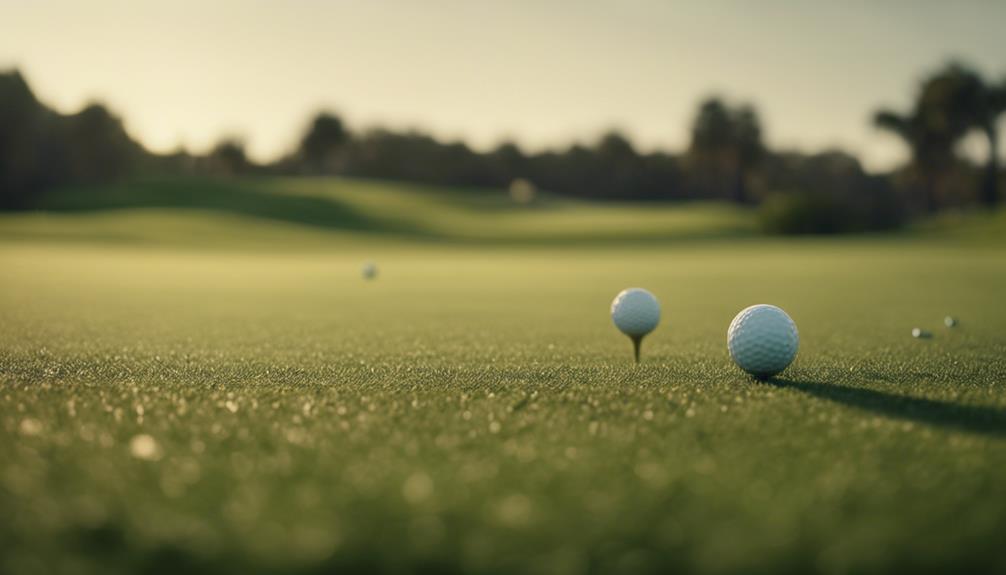
When choosing a driver, prioritize one that matches your swing speed and style with the correct loft and shaft flex, as this will have a significant impact on your overall game.
As a beginner, you need a driver that assists you in consistently hitting the ball onto the fairway. A driver with incorrect loft and flex can result in reduced distance and accuracy, making it more challenging for you to progress. That's why it's crucial to get it right from the beginning.
You should concentrate on a driver with sufficient loft to help you launch the ball high and straight. A higher loft can also aid in reducing a slice and promoting a more uniform swing.
Furthermore, the shaft flex should be suitable for your swing speed. If you have a slower swing, opt for a more flexible shaft, while a stiffer shaft is more appropriate for faster swings. By selecting a driver that suits your swing, you'll establish a solid foundation for your game and position yourself for success.
Keep in mind, the driver establishes the standard for the rest of your clubs, so invest the time to make the right choice.
Understanding Hybrid Clubs
As you shift from drivers to the rest of your golf club set, hybrid clubs are an essential addition to ponder, offering a unique blend of iron-like accuracy and wood-like distance. These clubs are designed to combine the best of both worlds, providing versatility and ease of use.
You'll find hybrid clubs are easier to hit than long irons, thanks to their larger clubhead and lower center of gravity. This design allows for a higher launch angle, giving you better control and forgiveness. Hybrid clubs are ideal for shots from the fairway or rough, providing the distance and accuracy you need to improve your game.
Many golfers find hybrid clubs more forgiving than traditional long irons, making them a great option for beginners. With hybrid clubs, you can expect a more consistent and reliable performance, even on off-center hits. By incorporating hybrid clubs into your set, you'll be able to tackle a variety of shots with confidence and precision.
Irons for Beginners
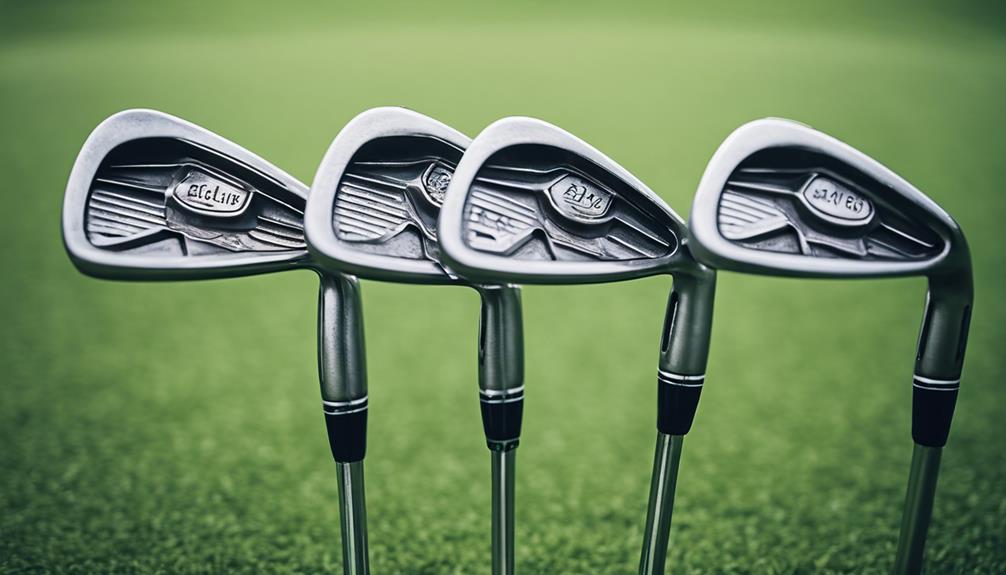
As you start building your iron set, you'll want to focus on two key areas: distance and accuracy.
You'll need irons that can help you cover varying distances on the course, while also providing forgiveness and consistency in your shots.
Irons for Distance
Your iron selection can make all the difference in achieving the distance you need to reach the green, so understanding how to choose the right one for your shot is vital.
When it comes to irons for distance, you'll want to focus on the lower-numbered irons in your set, such as the 6 iron, 7 iron, and 8 iron. These clubs are designed to hit the ball farther, making them ideal for longer approach shots.
As a beginner, it's important to understand that irons are numbered based on their loft angle, with lower numbers providing more distance and higher numbers offering more loft for shorter shots.
Having a full set of irons, including a 6 iron, 7 iron, 8 iron, and 9 iron, will give you the versatility to tackle different situations on the course. You may also consider using irons or hybrids, depending on your swing style and preferences.
Irons for Accuracy
Mastering irons for accuracy is essential for beginners, since these clubs are designed to deliver precision and control in approach shots and shorter distances on the course. As you start your golfing journey, focus on using mid to short irons like 7, 8, and 9 irons for better control and consistency. These irons will help you develop your skills in shaping shots and controlling trajectory.
| Iron Type | Characteristics | Benefits for Beginners |
|---|---|---|
| Cavity Back | Larger sweet spot, more forgiving | Increased accuracy, reduced slices and hooks |
| Mid Irons (7-8) | Easier to control, consistent distance | Improved approach shots, better scoring |
| Short Irons (9) | Higher trajectory, softer landing | Better chip shots, more precise short game |
Irons with cavity back designs are more forgiving and offer larger sweet spots for off-center hits, making them perfect for beginners. A set of irons typically includes a range from 3 to 9, with higher numbers for shorter distances and lower numbers for longer shots. By mastering irons for accuracy, you'll be able to tackle the course with confidence and precision. Remember, practice makes perfect, so get out there and start honing your iron skills!
Wedges and Their Uses
When you're maneuvering through the challenging terrain near the green or finding yourself stuck in a bunker, wedges become your trusted allies, designed to deliver short-distance, high-precision shots that can save your score.
As a beginner, it's crucial to understand the different types of wedges and their uses. You'll typically need three wedges in your bag: a pitching wedge (PW), a gap wedge (GW), and a sand wedge (SW). The PW is used for full shots, while the GW bridges the gap between the PW and SW. The SW helps you escape bunkers, and a lob wedge (LW) can provide high, soft shots.
Wedges have higher lofts (typically ranging from 46-64 degrees) to generate more height and backspin on shots. Mastering wedge play is vital for scoring well and saving strokes on the golf course.
Don't think of wedges as optional clubs for beginners – they're indispensable for navigating the course's most challenging areas. Instead of reaching for wedges or hybrids, focus on developing a strong foundation with these three wedges, and you'll be well on your way to improving your game.
Putter Selection Made Easy
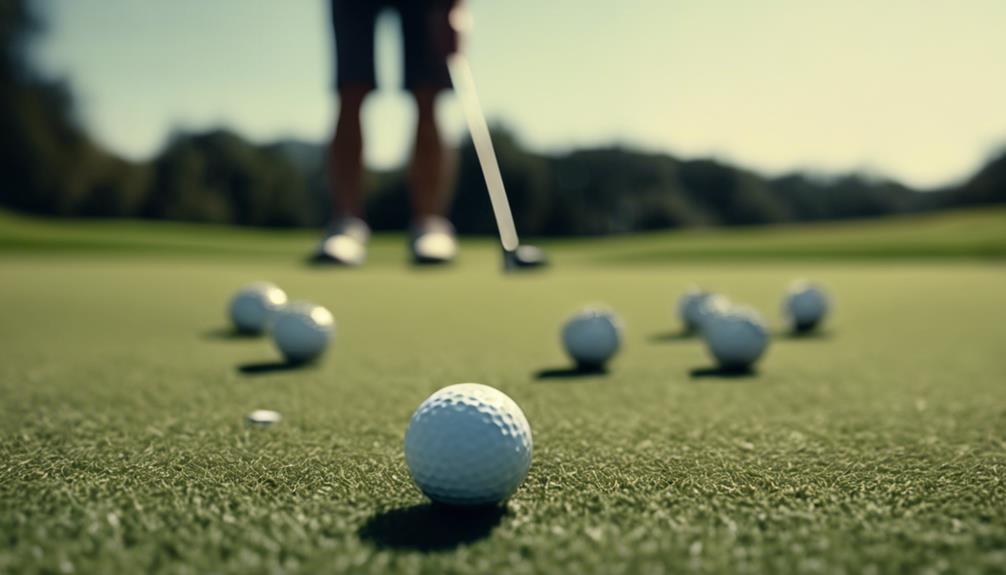
Selecting the appropriate putter can be a game-changer, as it's the club you'll use most frequently on the green, and a well-matched putter can significantly enhance your overall score. To find your ideal putter, consider the following key factors:
- Putter length: Make sure it's comfortable for your stance and posture.
- Head shape: Choose a shape that aligns with your putting style, whether it's a blade, mallet, or hybrid.
- Alignment aids: Look for features like lines, dots, or markings that help you align your putts accurately.
- Balance and weight distribution: A putter with the appropriate balance and weight will promote a smooth, consistent stroke.
When testing putters, pay attention to how they feel in your hands and how they respond to your putting style. You may also want to explore custom fitting options to guarantee your putter is tailored to your unique needs.
Graphite Shafts for Beginners
With your putter selection in hand, you're now ready to explore the benefits of graphite shafts, which can amplify your overall performance by increasing swing speed and distance.
As a beginner, you'll appreciate the lighter weight of graphite shafts, making them ideal for generating more club head speed. This increased speed translates to longer drives and more consistent shots. The flexibility of graphite shafts also allows for a smoother impact, enhancing your overall performance and feel.
When building your club set, incorporating graphite shafts can provide a more forgiving and enjoyable experience on the course. Novice golfers, in particular, benefit from the lighter weight and increased speed graphite shafts offer. By opting for graphite shafts in your clubs, you'll be able to improve your game without sacrificing control or accuracy.
With graphite shafts, you'll be able to take your game to the next level, making them an excellent choice for beginners looking to master the game.
Club Fitting for Consistency
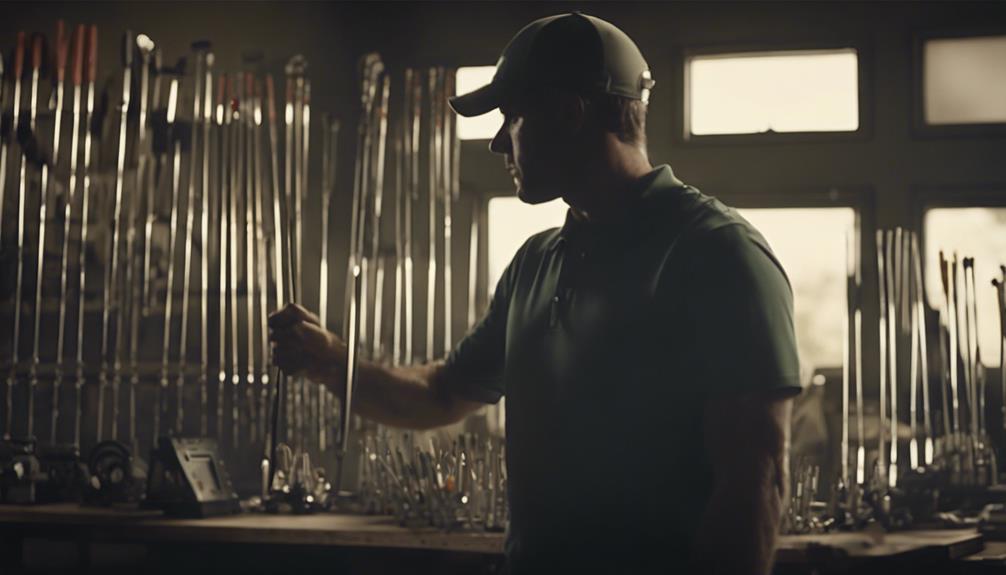
You'll take your game to the next level by maintaining consistent loft gaps between hybrids and irons, and club fitting is the key to achieving this peak performance. By getting fitted for the right clubs, you'll be able to make more precise shots and improve your overall game.
During a club fitting session, a launch monitor can help determine the proper shaft flex and club head speed for your swing. This ensures that you're getting the most out of your clubs and making steady shots.
Here are some key benefits of club fitting:
- Consistent loft gaps between hybrids and irons for best performance
- The right shaft flex for your swing speed, ensuring accuracy and consistency
- A better understanding of your swing foundation and practice habits, leading to more informed club selection
- Increased confidence on the course, knowing you have the right clubs for your game
Organizing Your Golf Bag
As you start to build your golf game, organizing your golf bag is crucial to make sure you can quickly find the right club when you need it.
You'll want to arrange your clubs in a logical order, use dividers to keep them organized, and prioritize easy access to essentials like golf balls and tees.
Club Organization Tips
Organizing your golf bag by club length, from shortest to longest, guarantees easy access to the right club at the right time during play. This simple trick saves you time and frustration on the course.
To take your club organization to the next level, consider these tips:
- Use club dividers to keep your clubs organized and prevent them from getting tangled.
- Consider using a towel or headcovers to protect your clubs and keep them clean.
- Utilize external pockets for storing accessories like tees, balls, gloves, and snacks.
- Keep your bag lightweight and comfortable to carry for a more enjoyable round of golf.
Golf Bag Essentials
Your golf bag should contain a well-curated selection of clubs, each chosen to tackle specific shots and situations on the course. To make sure you're adequately prepared, organize your bag by arranging clubs from shortest to longest for easy access during play.
A typical set of golf clubs should include a driver, woods, hybrids instead of fairway woods, irons, wedges, and putter. Having a mix of clubs in your bag allows for versatility in different shot situations on the course. Consider your skill level, personal preferences, and course conditions when organizing your bag.
Properly arranging your golf bag ensures you have the right club for each shot, which improves overall performance. By thoughtfully curating your set of golf clubs, you'll be better equipped to tackle the challenges of the course.
Take the time to thoughtfully arrange your bag, and you'll be on your way to mastering the game.
Expanding Your Club Set
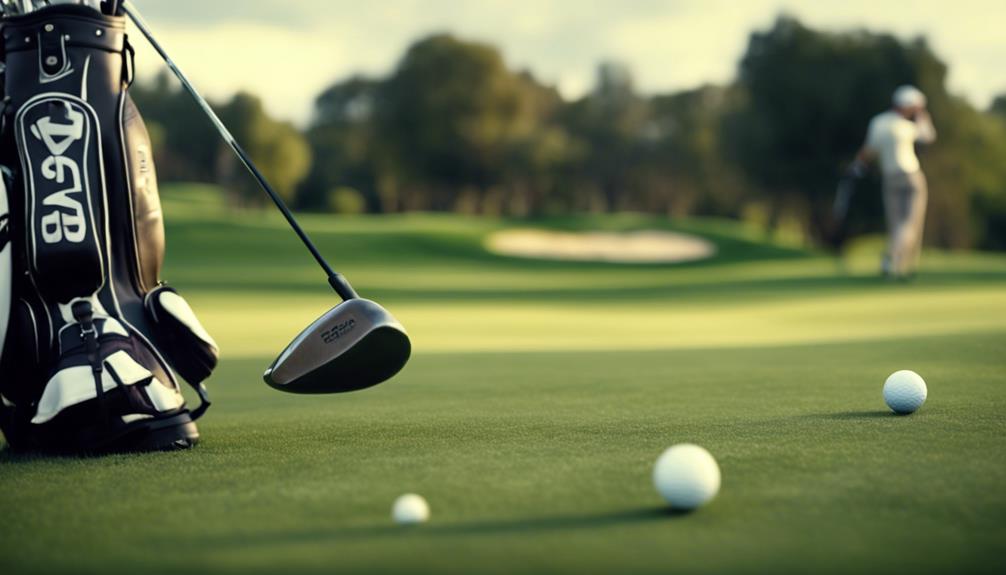
Now that you've got the basics covered, it's time to start thinking about expanding your club set to elevate your game. You've mastered the fundamentals, and it's time to add some new tools to your arsenal.
Expanding your club set can increase your versatility and help you tackle a wider range of shots.
Here are some clubs to contemplate adding to your set:
- A 5 or 7 wood for longer shots off the tee
- A 6 hybrid for easier shots out of the fairway and rough
- An 8 iron for shorter shots to the green and for chipping around the green
- A sand wedge for playing out of bunkers and adding versatility to your club set
Customizing Your Golf Experience
Customization becomes an essential aspect of your golf journey as you refine your skills and develop a unique playing style. As you start playing, you'll realize that a standard set of golf clubs might not be the perfect fit for you. To optimize your performance, you need to take into account factors like course conditions, distance requirements, and personal preferences when selecting your golf clubs.
| Factors to Take into Account | Customization Options |
|---|---|
| Course Conditions | Choose clubs with more forgiveness for beginners or those with slower swing speeds |
| Distance Requirements | Select clubs with more loft for higher shots or those with less loft for lower shots |
| Personal Preferences | Experiment with different grip sizes, clubhead materials, and shaft flexes to find your comfort zone |
Frequently Asked Questions
How Many Clubs Do You Need to Start Golfing?
When selecting your first clubs, you'll need a minimum of 7, including a driver, putter, and essential irons and wedges, but budget options exist for a smaller set, allowing you to prioritize club selection and grow your collection over time.
How Many Clubs Should I Have in My Bag?
When selecting clubs for your bag, you'll want to contemplate club selection, bag organization, and club customization to optimize your game. You can start with a minimalist approach and add clubs as you refine your swing and style.
How Do I Choose a Set of Golf Clubs for Beginners?
"Picture yourself swinging with confidence, choosing the perfect clubs. Consider club fitting options to find your ideal match, set a budget, and look for beginner-friendly features like hybrids and forgiving irons to help you master the game."
How Few Clubs Can You Play Golf With?
You can play golf with minimal equipment, and budget options are available, but consider custom fittings to optimize your game; with as few as 7 clubs, you can focus on shot-making and accuracy, improving your overall performance.
Conclusion
You've made it! You're now equipped with the knowledge to build a solid golf set that suits your game.
But, you might be thinking, 'I'm not sure if I'm ready to invest in a full set of clubs just yet.'
Don't let that hold you back – even a basic set will get you started, and you can always add more clubs as you grow in the game.
The most important thing is to get out there and start playing – your passion for golf will only grow from here.




